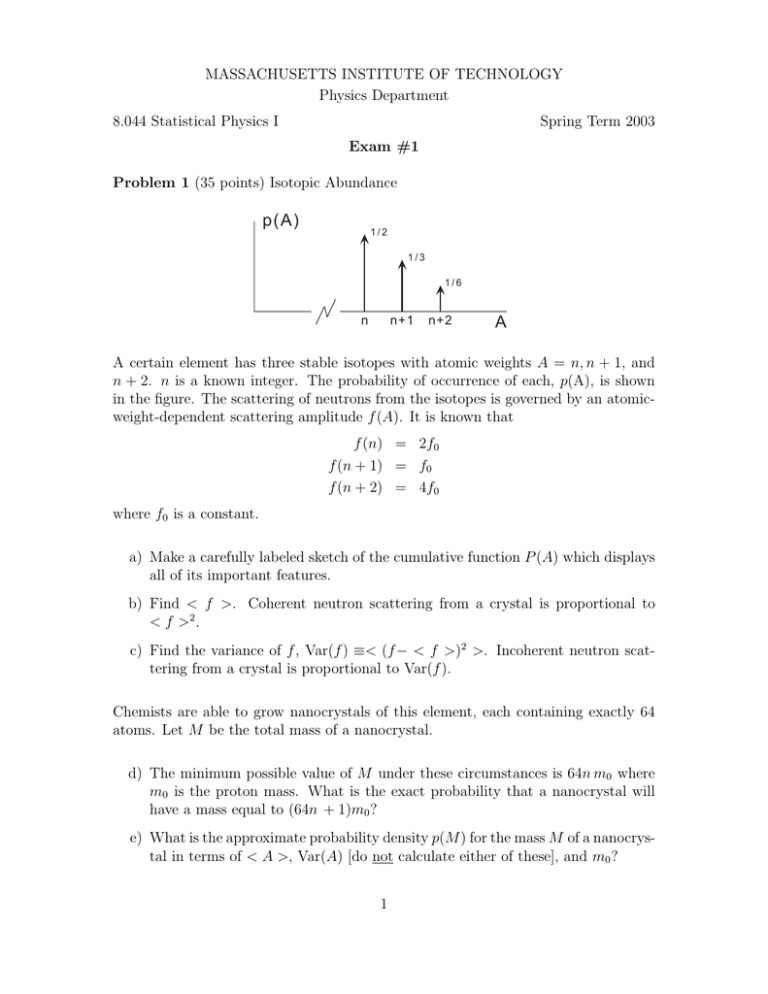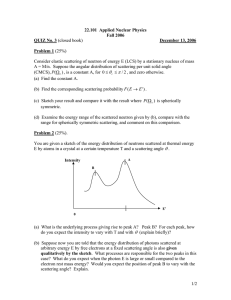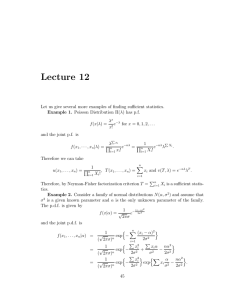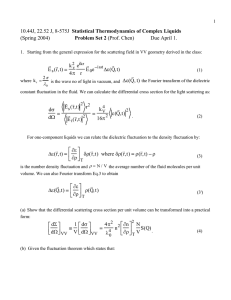p(A) A
advertisement

MASSACHUSETTS INSTITUTE OF TECHNOLOGY Physics Department 8.044 Statistical Physics I Spring Term 2003 Exam #1 Problem 1 (35 points) Isotopic Abundance p(A) 1/2 1/3 1/6 n n+1 n+2 A A certain element has three stable isotopes with atomic weights A = n, n + 1, and n + 2. n is a known integer. The probability of occurrence of each, p(A), is shown in the figure. The scattering of neutrons from the isotopes is governed by an atomicweight-dependent scattering amplitude f (A). It is known that f (n) = 2f0 f (n + 1) = f0 f (n + 2) = 4f0 where f0 is a constant. a) Make a carefully labeled sketch of the cumulative function P (A) which displays all of its important features. b) Find < f >. Coherent neutron scattering from a crystal is proportional to < f >2 . c) Find the variance of f , Var(f ) ≡< (f − < f >)2 >. Incoherent neutron scat­ tering from a crystal is proportional to Var(f ). Chemists are able to grow nanocrystals of this element, each containing exactly 64 atoms. Let M be the total mass of a nanocrystal. d) The minimum possible value of M under these circumstances is 64n m0 where m0 is the proton mass. What is the exact probability that a nanocrystal will have a mass equal to (64n + 1)m0 ? e) What is the approximate probability density p(M ) for the mass M of a nanocrys­ tal in terms of < A >, Var(A) [do not calculate either of these], and m0 ? 1 Problem 2 (30 points) Field Reversals The earth’s magnetic field changes suddenly at random times as the earth evolves. A possible model for this behavior gives the following joint probability density for the magnetic fields B1 and B2 measured at two different times separated by t years. 1 exp[−t/τ ] δ(B1 − B2 ) exp[−B12 /2σ 2 ] 2πσ 2 1 (1 − exp[−t/τ ]) exp[−(B12 + B22 )/2σ 2 ] + 2 2πσ p(B1 , B2 ) = √ τ is a parameter of the order of 5 × 105 years and σ is a parameter of the order of 1/2 gauss. a) Find p(B1 ). Sketch the result. b) Find the conditional probability density p(B2 |B1 ). Sketch the result. c) Are B1 and B2 statistically independent? Explain your reasoning. 2 Problem 3 (35 points) Rutherford Scattering θ π θ b 0 b In Rutherford scattering of mono-energetic α particles from nuclei, the dependence of the scattering angle θ on the impact parameter b is given by θ = 2 arccot(b/l) (as shown in the figure above) where l is a characteristic length. The impact parameter b is the closest distance the α particle would come to the nucleus if there were no Coulomb interaction. y In the following assume that the α particle flux is uniform over a disk of radius R centered on the nucleus. Thus b is in the range from 0 to R. R x a) Find p(b) and sketch the result. b) What is the smallest possible scattering angle? c) Find p(θ) and sketch the result. 3 Derivatives of Trigonometric Functions d cot x = −csc2 x. dx d sec x = sec x tan x. dx d csc x = − csc x cot x. dx d sin x = cos x. dx d cos x = − sin x. dx d tan x = sec2 x. dx Definite Integrals For integer n and m ∞ xn e−x dx = n! 0 ∞ −x e √ dx = x 0 2 −1/2 (2πσ ) ∞ 0 1 0 √ ∞ −∞ x e−x dx = 2 π x2n e−x 2 /2σ 2 dx = 1 · 3 · 5 · · · (2n − 1) σ n 1 2 xm (1 − x)n dx = n!m! (m + n + 1)! 4 MIT OpenCourseWare http://ocw.mit.edu 8.044 Statistical Physics I Spring 2013 For information about citing these materials or our Terms of Use, visit: http://ocw.mit.edu/terms.








